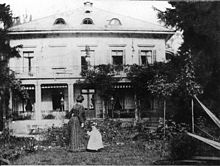Belvoirpark
The Belvoirpark is a public park in Zurich . Its history is inextricably linked with the former owners, the Escher family. Heinrich Escher-Zollikofer established the property around 1830. His son Alfred Escher , statesman, railway pioneer and co-founder of the Schweizerische Kreditanstalt, spent almost his entire life on the estate and enjoyed the privacy of the refuge.
The city of Zurich has owned the Belvoir since 1901. This was preceded by what is probably the most unusual rescue operation in the history of the Zurich gardens.
The Belvoirpark is one of those facilities that have been developed and built over the years. As early as the 19th century, the park had to accept significant interventions such as the loss of the edge of the lake due to the construction of the Zurichseebahn railway on the left bank and the embankment of the lake. At the beginning of the 20th century, a good 11,000 square meters of parkland along the Seestrasse were sold as building land as part of the rescue operation for the park.
The Swiss Horticultural Exhibition G59 brought the Belvoirpark to be merged with the neighboring Schneeligut. The iris and daylily gardens followed the G59 installations in the 1980s .
history
Heinrich Escher-Zollikofer (1776–1853), known as "America-Escher", became very wealthy at a young age through trading and land speculation in North America.
In 1826 he bought the "Wyssbühel", a hill overgrown with vines right on the lake. According to his own plans, the hilltop was removed, the material used to fill in the marshy bank and the area was planted with exotic trees, some of which came from America.
The high-classical villa in the center of the complex was built between 1828 and 1831 and moved into Heinrich Escher with his wife Lydia Zollikofer and their two children, Clementine and Alfred. In addition to his scientific collections and studies, he devoted himself particularly to the design and maintenance of his country estate, which he called “Belvoir”.
Heinrich Escher died in 1853 and bequeathed the Belvoir to his son Alfred. The construction of the lakeshore railway on the left bank (from 1872) meant a serious intervention for the facility, as the Belvoir lost its direct access to the lake through the railway line. When Alfred Escher died in 1882, he bequeathed the Belvoir to his daughter Lydia Welti-Escher . Lydia Welti-Escher allowed all of her assets to flow into the Gottfried Keller Foundation , the purpose of which was to acquire important works of fine art at home and abroad and bequeathed the foundation to the Swiss Confederation after her death. The Federal Council, as administrator of this foundation, planned to sell the Belvoirpark in order to meet the conditions attached to the donation. When this became known, prominent Zurich residents formed an initiative committee with the aim of saving the park from the threat of overbuilding. Since the city of Zurich was unable to raise the necessary money to buy the Belvoir, the population was called to buy shares to save the park. The required amount was collected within a few days.
In order to finance further maintenance, the Belvoir-Park-Gesellschaft had to retire building plots along the Seestrasse that were built over until the turn of the century. When the city of Zurich took over the Belvoir in 1901, the city council thanked the Belvoir Park Society for preventing the “appalling loss of the treasure”.
Today the villa houses the Belvoirpark restaurant, which is run by the Belvoirpark hotel management school .
investment
Belvoirpark is one of Zurich's earliest landscape gardens and aroused much admiration and envy. Three factors determine the fascination of the garden: The location with the magnificent view of the city, lake and mountains, the varied and exciting terrain design and the abundant tree backdrop, which was unusual for the time.
In 1881, a double-row poplar avenue lined the entrance to the villa, which led past the greenhouse and the stables. The villa lies at the highest point, embedded in large groups of trees that frame the view. The flower parterre extends to the southeast with fountains, carpeted beds and banana palms . At its southern end, on the edge of the artificially flattened hilltop, the view of the lake and mountains opens up. At the foot of the hill, the park had a lake border. Groups of trees set striking accents on the extensive meadow areas. A large kitchen garden with a utility building completes the park in the southwest corner.
Iris garden Belvoirpark
A large garden with irises , called the iris garden , can be found in the lower area. It was created in 1985. The more than 120 varieties - wild forms and cultivars - have their flowering period from March (miniature iris) to July (high bearded iris). Swamp irises , iris flowers and peonies grow by the pond .
Web links
- Green City Zurich website ( Memento from May 27, 2011 in the Internet Archive )
Individual evidence
- ↑ a b c Belvoir Park. Green City of Zurich, 2007.
- ↑ Belvoir Park Iris Garden. Green City of Zurich, 2007
Coordinates: 47 ° 21 '24.2 " N , 8 ° 32' 1.1" E ; CH1903: 682726 / 245 675




